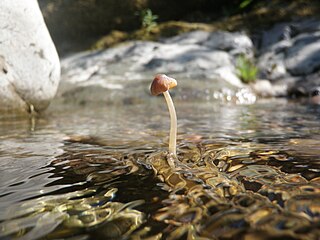
The Burkholderiales are an order of Betaproteobacteria in the phylum Pseudomonadota. Like all Pseudomonadota, they are Gram-negative. They include several pathogenic bacteria, including species of Burkholderia, Bordetella, and Ralstonia. They also include Oxalobacter and related genera, which are unusual in using oxalic acid as their source of carbon. Other well-studied genera include Alcaligenes, Cupriavidus, Achromobacter, Comamonas, Delftia, Massilia, Duganella, Janthinobacterium, Polynucleobacter, non-pathogenic Paraburkholderia, Caballeronia, Polaromonas, Thiomonas, Collimonas, Hydrogenophaga, Sphaerotilus, Variovorax, Acidovorax, Rubrivivax and Rhodoferax, and Herbaspirillum.

Pachira aquatica is a tropical wetland tree in the mallow family Malvaceae, native to Central and South America where it grows in swamps. It is known by its common names Malabar chestnut, French peanut, Guiana chestnut, Provision tree, Saba nut, Monguba (Brazil), Pumpo (Guatemala) and Jelinjoche and is commercially sold under the names Money tree and Money plant. This tree is sometimes sold with a braided trunk and is commonly grown as a houseplant, although more commonly what is sold as a "Pachira aquatica" houseplant is in fact a similar species, P. glabra.
Hydrogenophaga is a genus of comamonad bacteria, several of which were formerly classified in the genus Pseudomonas.

Psathyrella aquatica is a species of fungus from Oregon, first described in the journal Mycologia in 2010. It represents the first ever report of a gilled basidiomycete fruiting underwater.
The enzyme 4-sulfomuconolactone hydrolase (EC 3.1.1.92; systematic name 4-sulfomuconolactone sulfohydrolase This enzyme catalyses the following chemical reaction
Hydrogenophaga atypica is a Gram-negative, oxidase-positive, rod-shaped, motile bacterium from the Comamonadaceae family, which was isolated from wastewater from an activated sludge. The colonies of H. atypica are pale yellow.
Hydrogenophaga bisanensis is a Gram-negative, non-spore-forming, rod-shaped bacterium from the Comamonadaceae family, which was isolated from wastewater from a textile dye works in Korea. Colonies of H. bisanensis are moderate yellow in color.
Hydrogenophaga caeni is a Gram-negative, anaerobic, catalase- and oxidase-positive, motile bacterium from the Comamonadaceae family, with a single polar flagellum, which was isolated from an activated sludge. Colonies of H. caeni are white colored.
Tepidimonas aquatica is a gram-negative, aerobic, oxidase and catalase-positive thermophilic, rod-shaped, motile bacterium, with one polar flagellum from the genus Tepidimonas, which was isolated from a domestic water tank in Coimbra.
Luteimonas aquatica is a species of yellow-pigmented bacteria. It is Gram-negative, rod-shaped and non-spore-forming, with type strain RIB1-20(T).
Arcicella is a genus of aerobic bacteria from the family of Spirosomaceae.
Hydrogenophaga luteola is a bacterium from the genus of Hydrogenophaga which has been isolated from pond water from Shangqiu in China.
Roseomonas aquatica is a species of Gram negative, strictly aerobic, coccobacilli-shaped, pale pink-colored bacterium. It was first isolated from drinking water from Seville, Spain. The species name is derived from the Latin aquatica.
Hydrogenophaga crassostreae is a Gram-negative, rod-shaped, aerobic and motile bacterium from the genus of Hydrogenophaga which has been isolated from the oyster Crassostrea gigas.
Hydrogenophaga laconesensis is a Gram-negative, non-spore-forming and motile bacterium from the genus of Hydrogenophaga which has been isolated from well water.
Hydrogenophaga soli is a Gram-negative, rod-shaped, strictly aerobic and motile bacterium from the genus of Hydrogenophaga which has been isolated from soil from a rice field from Goyang in Korea.
Solimonas aquatica is a Gram-negative, aerobic, rod-shaped, non-spore-forming and motile bacterium from the genus of Solimonas which has been isolated from a water spring from Kaohsiung in Taiwan.
Terrimonas aquatica is a Gram-negative, rod-shaped, aerobic and non-motile bacterium from the genus of Terrimonas which has been isolated from a freshwater spring from Taiwan.

Pachira glabra is a tropical wetland tree in the mallow family, Malvaceae, native to eastern Brazil, where it grows along waterways. It is generally known by the nonscientific names Guinea peanut, French peanut, Saba nut, money tree, and lucky tree. It shares many of these common names with the similar P. aquatica.
Paracnuella is a Gram-negative, rod-shaped and motile genus of bacteria from the family of Chitinophagaceae with one known species. Paracnuella aquatica has been isolated from water from a thermal spring in China.



